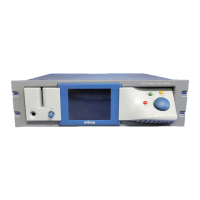3-38
OPERATION ORBAN Model 8400
Final Clip Drive control adjusts the level of the audio driving the back end clipping sys-
tem that OPTIMOD-FM uses to control fast peaks. The loudness/distortion trade-off is
primarily determined by the
Final Clip Drive control.
Turning up the
Final Clip Drive control drives the final clipper and overshoot compensa-
tor harder, reducing the peak-to-average ratio, and increasing the loudness on the air.
When the amount of clipping is increased, the audible distortion caused by clipping is
increased as well. Lower settings of the
Final Clip Drive control reduce loudness, of
course, but result in a cleaner sound.
If the
Multiband Release control is set to its faster settings, the distortion produced by the
back-end clipping system will increase as the
Multiband Drive control is advanced. The
Final Clip Drive
and/or the MB Limit Thr (Multiband Limit Threshold) controls may have
to be turned down to compensate. To best understand how to make loudness/distortion
trade-offs, perhaps the wisest thing to do is to recall a factory multiband preset, and then
to adjust the
Less/More control to several settings throughout its range. At each setting of
the
Less/More control, examine the settings of the Multiband Drive and MB Limit Thr con-
trols. This way, you can see how the factory programmers made the trade-offs between
the settings of the various distortion-determining controls at various levels of processing.
The 8400’s multiband clipping and distortion control system works to help
prevent audible distortion in the final clipper. As factory programmers, we
prefer to adjust the
Final Clip Drive control over a very narrow range (typi-
cally –0.5 dB to –1.0 dB) and to determine almost all of the loud-
ness/distortion trade-off by the setting of the
Multiband Clipping control.
The final clipper operates at 256 kHz sample rate and is fully anti-aliased.
Composite Clip Drive sets the drive level, in dB, into the 8400’s composite limiter
(which is not a clipper, despite this control’s name).
This control has no effect on the 8400’s left and right analog or digital out-
puts.
The
Composite Clip Drive control is set to “0 dB” for most factory presets.
At this setting, it removes a few tenths of a dB of residual overshoot from
the audio processing without affecting audio quality. We prefer to use the
audio-domain overshoot compensation to do most of the work because it op-
erates at a 256 kHz sample rate and is fully anti-aliased, whereas the com-
posite limiter will inevitably introduce aliasing around 38 kHz upon de-
modulation in the receiver. This is because it introduces spectrum in the ste-
reo subchannel area when it clips material in the 0 to 15 kHz area. The re-
ceiver will “see” this as stereo material, and will demodulate it as if it were
part of the stereo subchannel. Accordingly, harmonics of L+R material will
be frequency-shifted upon demodulation, and will no longer bear a harmonic
relationship to the material that produced them. Mathematically, these har-
monics will be located at the same frequencies as harmonics caused by clip-
ping in a simple digital-domain clipper (with no anti-aliasing) operating at
38 kHz sample rate.
If you want to use the composite limiter more heavily, one option is to trade
off composite limiting against left/right domain overshoot compensation. To

